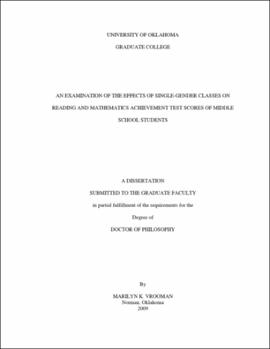| dc.contributor.advisor | Maiden, Jeffrey M | |
| dc.creator | Vrooman, Marilyn Kaye | |
| dc.date.accessioned | 2019-04-27T21:21:43Z | |
| dc.date.available | 2019-04-27T21:21:43Z | |
| dc.date.issued | 2009 | |
| dc.identifier | 99124277902042 | |
| dc.identifier.uri | https://hdl.handle.net/11244/318496 | |
| dc.description.abstract | Educational strategies begin with student achievement in mind. Over time these strategies change to include new scientific information and sometimes change to include past practices. This quantitative research study incorporates both elements of change. As neuroscience explores the brain and its functions, a new look is given to the learning strategies that capsulate from scientific findings on how the brain works to find meaning from new information. It also encompasses the gender differences found in the functions of the brain and its overall effect on learning. This information in addition to the old practice of educating students based on gender provides a new context for educating students in a changing world. | |
| dc.description.abstract | The historical background and literature review look at changes and legislative barriers that moved education away from single-gender education. It also outlines the controversial practice as seen in the past context and as seen currently through various research studies. Research concerns on differentiated learning styles of students based on gender are discussed thoroughly and suggestions for practice are included. Due to a limited number of studies in the United States, studies from other countries have been examined | |
| dc.description.abstract | This study utilizes the brain-based learning theory to embed learning strategies into single-gender classroom settings within a co-education school and compares its findings to two other traditional co-education classroom schools. The findings are derived from analyzing six factorial analyses of covariance on three years of middle school student test scores for years 2006, 2007 and 2008, and grades six, seven and eight. Descriptive statistics are included in this study. After controlling for full academic year (FAY) students, students that have a previous grade's post-test score, gender and grade level, there were significant findings in single-gender school (group) in mathematics for all three grades. There were no significant findings for subgroups in mathematics. There were no significant findings for any group or subgroups in reading. | |
| dc.description.abstract | Trends in student achievement were found within the schools under research and the state reporting data. These trends open another area of concern for student achievement and are recommended for future study. Future research is suggested to determine significant differences in school and classroom environments due to single-gender configurations, including discipline, teacher and student attitudes and parental involvement. A plethora of quantitative and qualitative studies can be added to the current body of knowledge based on the practice of brain-based learning and single-gender teaching. | |
| dc.format.extent | 124 pages | |
| dc.format.medium | application.pdf | |
| dc.language | en_US | |
| dc.relation.requires | Adobe Acrobat Reader | |
| dc.subject | Reading (Middle school) | |
| dc.subject | Mathematics--Study and teaching (Middle school) | |
| dc.subject | Single-sex classes (Education) | |
| dc.title | An Examination of the Effects of Single-Gender Classes on Reading and Mathematics Achievement Test Scores of Middle School Students | |
| dc.type | text | |
| dc.type | document | |
| dc.thesis.degree | Ph.D. | |
| ou.group | Jeannine Rainbolt College of Education::Department of Educational Leadership and Policy Studies | |
